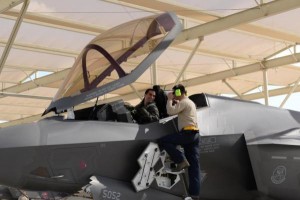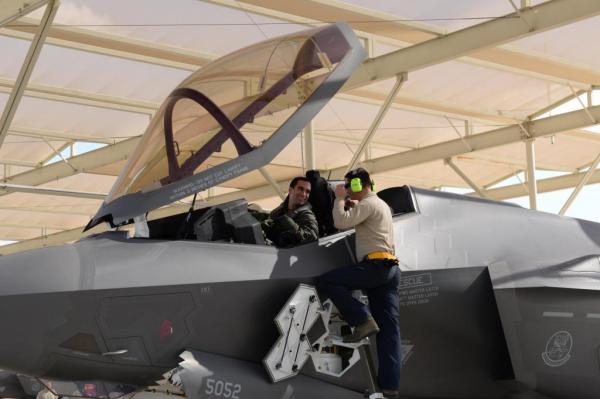2015-11-09 By Robbin Laird
We have argued for some time that as the F-35 got into the hands of the warriors, the renorming revolution started with the the F-22 would accelerate.
We have also highlighted for some time, that the F-35 is not simply an airplane, but a global air system in the hands of the U.S. services and the core allies would shape a new way of working together moving forward.
Italy is a key plank holder in the F-35 global enterprise, and their two first flights this year highlight their crucial and visionary role.
The Italians have built a final assembly line on which to build their jets as well a those of the Dutch.
And this final assembly facility in Cameri – one of three with the main one in Fort Worth and an additional one being built in Japan – will be the foundation for a broader sustainment effort not only for Italy but its allies operating in the region.
The first of two historic flights was the first jet assembled at Cameri taking to the skies of Italy.
On Sept. 7, the first F-35A assembled outside the US, made its very first flight from Cameri airbase.
The aircraft, designated AL-1, is the first of eight aircraft currently being assembled at the Final Assembly and Check Out (FACO) facility at Cameri, in northwestern Italy.
During the flight, that lasted about 1,5 hours, the F-35A was escorted by a Eurofighter Typhoon.
As Secretary Wynne, the man who started the talks on building the Italian facility with the Italians put it with regard to the importance of the event:
“This flight makes the F-35 truly an international program.”
It was hard to miss the meaning and impact of this first flight.
But the second first flight, where Italian student pilots took to the skies of Arizona from Luke AFB, might just look like a new training flight for the Italians have trained with the USAF for many years.
But that would be to miss the underlying point – the USAF is learning to fly its most advanced jet AT PRECISELY THE SAME TIME as key allies.
Put bluntly, rather than learning to fly WITH the USAF on different jets, the Italians and other F-35 nations are shaping common training, tactics and procedures for a global fleet FROM THE GROUND UP.
When we were at Marine Corps Air Station Beaufort, we learned that British pilots flew USMC jets; and vice versa.
This is clearly the case at Luke as well, for one of the two Italian pilots actually flew an Aussie jet for his first flight.
This is not some kind of stunt or exercise; this is the kind of foundational capabilities, which can achieve significant advancement in coalition capabilities as we move forward.
It is commonly asserted that the U.S., Europeans, Asian and Middle East allies intend to fight in coalitions going forward; yet the most fundamental building block for enhanced capabilities to do so is simply staring the combat community in the face – the F-35 global fleet.
This about combat integration at the high end and an ability to operate throughout the entire Range of Military Operations.
The F-35 is no silver bullet to be used for a few hours of combat and then bring the legacy equipment; it is about deploying an aircraft which can multi-task in a variety of combat settings, rather than having to calibrated multi-mission sequential air taskings and large scale fleet configuration planning.

As Lt. General Preziosa, the head of the Italian Air Force put it in an interview in his office in Rome in late September 2015:
The F-22 and the F-35 are called fifth generation aircraft, but really the F-35 is the first airplane built for the digital age, we are rapidly moving from the dog-fight concept to the data-fight evolution of the broad utilization of air power.
It was conceived in and for that age, and is built around the decision tools in the cockpit and is in fact a “flying brain.”
And that makes it different from other aircraft.
It is a multi-tasking aircraft, and fits well into the I-phone age.
Other aircraft – with the exception of the F-22 – are built to maximize out as multi-mission aircraft, which execute tasks sequentially and directed to do so.
The F-35 fleet thinks and hunts and can move around the mission set as pilots operate in the battlespace and leverage the data fusion system.
It is a battlespace dominance aircraft; not a classic air superiority, air defense or ground attack aircraft.
It changes the classic distinctions; confuses them and defines a whole new way to look at a combat aircraft, one built for the joint force age as well.
The Army and the Navy will discover, as the F-35 fleet becomes a reality, how significant the F-35 is for their combat efforts.
http://breakingdefense.com/2015/10/italys-air-force-chief-on-the-f-35-eurofighter-and-predator/
I had a chance to talk with the two Italian pilots in a phone interview on November 6, 2015 and to get their perspective on their first flight and their sense of the way ahead.
Question: I assume that you went through what has become the basic syllabus of training of about seven weeks with simulators and classrooms, and then flew the jet?
Answer: We have about six weeks in the simulators and classroom training on the TTPs, (Tactics, Training and Procedures) to get read to fly the airplane. We have an exam with a USAF trainer and then we are ready to fly the jet.
Question: When we spent time with the Brits and the Marines, we learned that they flew each other’s aircraft, and you did the same by flying USAF and Aussie F-35s.
Could you explain how unusual this is at this phase of your training?
Answer: What you mention is one of the key points of this program.
Starting from training to tomorrow’s operations, we are learning from the ground up.
Shaping common TTPs is crucial to shaping an integrated approach.
We are training on the same basis from the ground up.
This is the very first combat aircraft program which has this capability built into.
We have come to Sheppard to train with the USAF, but it is a trainer, and we do not share TTPs as we are doing with the F-35.
We start with the shared TTPs and then go from there.
Question: In other discussions with experienced pilots who have become F-35 pilots, all mention that the mental furniture associated with operating a multi-mission aircraft versus a multi-tasking aircraft is very different.
They also emphasized how crucial it is to get into the F-35 to move on to understand the transformation of airpower.
What is your sense of this shift?
Answer: The aircraft is so easy to fly that you spend 99 per cent of your time shaping a strategy as you use your two screens.
You are focused on your mission, instead of flying your jet and trying to achieve your mission.
We are very happy to be part of the program and to understand from the ground up how significant a shift the F-35 coalition capability is going to be.
Of course, we are also happy to be building our own jets and bringing them to Luke next year.
The first five Italian-built jets will take off from Cameri and fly to Luke next year.
Question: You flew an Australian jet yesterday.
You do not normally work with Australian pilots, but you will get to know them from the ground up as well as you train at Luke and fly each other’s jets.
What is your sense of this dynamic?
Answer: The young guys will grow up in a very advanced warfighting and multi-national environment because of this program.
They will be used to not just working together from time to time in an exercise, but will build in common tactics from the ground up and help each other innovate as well.
Question: We went to ACC recently, and one of the points made was that there are very few F-22 pilots free to work the culture of air power transformation based on their experience.
With the F-35 program, there is the opportunity to generate many more pilots and for these pilots to trigger ongoing airpower transformation.
What is your take on this opportunity?
Answer: Usually when we have exercises, we have to integrate on your own type of jet.
Here you are working from the ground up to shape an integrated approach.
It is hard for non-pilots to understand how significant this difference between shaping interoperability via exercises versus integration built in from the ground up.
Question: What does an integrated F-35 fleet bring to coalition combat, from your point of view?
Answer: We will write the TTPs together.
The commonality from the very beginning will be built into any operation which you do with your coalition partners.
And we are working from the ground up with the USAF, which is different as well from before.
We have made significant progress in the past two years, which is often not grasped by those not involved in the program.
And let me return to the point we discussed earlier about the difference between multi-mission and multi-tasking and the impact on operations.
You do not have to switch your configurations for air-to-air to air-to-ground or whatever the mission for which you have been pre-configured.
You can do what you need to do with the situational awareness built into the jet and the fleet and then fly to the mission.


